MOT相关
核心参考
核心参考:目标跟踪初探(DeepSORT)
核心参考:Sort和Deepsort原理解析及在JDE和Fairmot中的应用
核心技术
匈牙利算法(Hungarian Algorithm)
C语言实现,b站视频
匈牙利算法解决的是分配问题,是一个为了解决二分图问题的一种匹配算法,复杂度 \(O(n^3)\) 。使用方法如下
import numpy as np
from sklearn.utils.linear_assignment_ import linear_assignment
from scipy.optimize import linear_sum_assignment
cost_matrix = np.array([
[15,40,45],
[20,60,35],
[20,40,25]
])
matches = linear_assignment(cost_matrix)
print('sklearn API result:\n', matches)
matches = linear_sum_assignment(cost_matrix)
print('scipy API result:\n', matches)
"""Outputs
sklearn API result:
[[0 1]
[1 0]
[2 2]]
scipy API result:
(array([0, 1, 2], dtype=int64), array([1, 0, 2], dtype=int64))
"""
卡尔曼滤波(Kalman Filter)
用于修正传感器的测量值,达到更精确的估计
假设我们要跟踪小车的位置变化,如下图所示,蓝色的分布是卡尔曼滤波预测值,棕色的分布是传感器的测量值,灰色的分布就是预测值基于测量值更新后的最优估计。
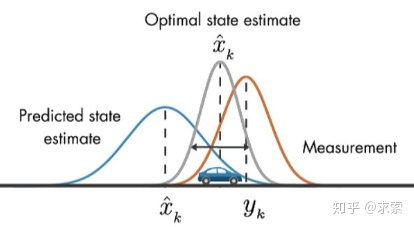
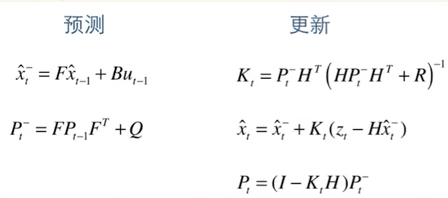

在目标跟踪中,需要估计track的以下两个状态:
- 均值(Mean):表示目标的位置信息,由bbox的中心坐标 (cx, cy),宽高比r,高h,以及各自的速度变化值组成,由8维向量表示为 x = [cx, cy, r, h, vx, vy, vr, vh],各个速度值初始化为0。
- 协方差(Covariance ):表示目标位置信息的不确定性,由8x8的对角矩阵表示,矩阵中数字越大则表明不确定性越大,可以以任意值初始化。
卡尔曼滤波分为两个阶段:(1) 预测track在下一时刻的位置,(2) 基于detection来更新预测的位置。
下面将介绍这两个阶段用到的计算公式。(这里不涉及公式的原理推导,因为我也不清楚原理(ಥ_ಥ) ,只是说明一下各个公式的作用)
预测
基于track在t-1时刻的状态来预测其在t时刻的状态。
当一个小车移动后,且其初始定位和移动过程都是高斯分布时,则最终估计位置分布会更分散,即更不准确
说白话就是,使用k-1态的最优结果,加上k-1态的状态控制量(是否精确取决于系统的运动方程是否精确)
其中 \(F\) 为状态转移矩阵, \(P\) 为协方差矩阵, \(Q\) 为噪声矩阵(代表系统可靠性,一般为极小值)。由下图可以发现卡尔马滤波是匀速模型。
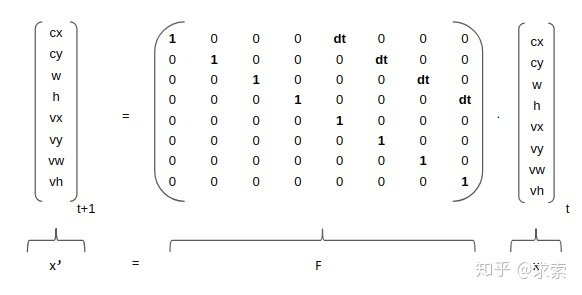
# kalman_filter.py
def predict(self, mean, covariance):
"""Run Kalman filter prediction step.
Parameters
----------
mean: ndarray, the 8 dimensional mean vector of the object state at the previous time step.
covariance: ndarray, the 8x8 dimensional covariance matrix of the object state at the previous time step.
Returns
-------
(ndarray, ndarray), the mean vector and covariance matrix of the predicted state.
Unobserved velocities are initialized to 0 mean.
"""
std_pos = [
self._std_weight_position * mean[3],
self._std_weight_position * mean[3],
1e-2,
self._std_weight_position * mean[3]]
std_vel = [
self._std_weight_velocity * mean[3],
self._std_weight_velocity * mean[3],
1e-5,
self._std_weight_velocity * mean[3]]
motion_cov = np.diag(np.square(np.r_[std_pos, std_vel])) # 初始化噪声矩阵Q
mean = np.dot(self._motion_mat, mean) # x' = Fx
covariance = np.linalg.multi_dot((self._motion_mat, covariance, self._motion_mat.T)) + motion_cov # P' = FPF(T) + Q
return mean, covariance
更新
基于t时刻检测到的detection,校正与其关联的track的状态,得到一个更精确的结果。
当一个小车经过传感器观测定位,且其初始定位和观测都是高斯分布时,则观测后的位置分布会更集中,即更准确
说白话就是,通过k态的观测值,与k态估计值,生成k态最优结果,并对相应的矩阵(运动状态方程)进行更新。
在公式1中,z为detection的均值向量,不包含速度变化值,即z=[cx, cy, r, h],H称为测量矩阵,它将track的均值向量x'映射到检测空间,该公式计算detection和track的均值误差;
在公式2中,R为检测器的噪声矩阵,它是一个4x4的对角矩阵,对角线上的值分别为中心点两个坐标以及宽高的噪声,以任意值初始化,一般设置宽高的噪声大于中心点的噪声,该公式先将协方差矩阵P'映射到检测空间,然后再加上噪声矩阵R;
公式3计算卡尔曼增益K,卡尔曼增益用于估计误差的重要程度;
公式4和公式5得到更新后的均值向量x和协方差矩阵P。
# kalman_filter.py
def project(self, mean, covariance):
"""Project state distribution to measurement space.
Parameters
----------
mean: ndarray, the state's mean vector (8 dimensional array).
covariance: ndarray, the state's covariance matrix (8x8 dimensional).
Returns
-------
(ndarray, ndarray), the projected mean and covariance matrix of the given state estimate.
"""
std = [self._std_weight_position * mean[3],
self._std_weight_position * mean[3],
1e-1,
self._std_weight_position * mean[3]]
innovation_cov = np.diag(np.square(std)) # 初始化噪声矩阵R
mean = np.dot(self._update_mat, mean) # 将均值向量映射到检测空间,即Hx'
covariance = np.linalg.multi_dot((
self._update_mat, covariance, self._update_mat.T)) # 将协方差矩阵映射到检测空间,即HP'H^T
return mean, covariance + innovation_cov
def update(self, mean, covariance, measurement):
"""Run Kalman filter correction step.
Parameters
----------
mean: ndarra, the predicted state's mean vector (8 dimensional).
covariance: ndarray, the state's covariance matrix (8x8 dimensional).
measurement: ndarray, the 4 dimensional measurement vector (x, y, a, h), where (x, y) is the
center position, a the aspect ratio, and h the height of the bounding box.
Returns
-------
(ndarray, ndarray), the measurement-corrected state distribution.
"""
# 将mean和covariance映射到检测空间,得到Hx'和S
projected_mean, projected_cov = self.project(mean, covariance)
# 矩阵分解(这一步没看懂)
chol_factor, lower = scipy.linalg.cho_factor(projected_cov, lower=True, check_finite=False)
# 计算卡尔曼增益K(这一步没看明白是如何对应上公式5的,求线代大佬指教)
kalman_gain = scipy.linalg.cho_solve(
(chol_factor, lower), np.dot(covariance, self._update_mat.T).T,
check_finite=False).T
# z - Hx'
innovation = measurement - projected_mean
# x = x' + Ky
new_mean = mean + np.dot(innovation, kalman_gain.T)
# P = (I - KH)P'
new_covariance = covariance - np.linalg.multi_dot((kalman_gain, projected_cov, kalman_gain.T))
return new_mean, new_covariance
马氏距离(Mahalanobis Distance)
用于应对高维线性分布的数据中各维度间非独立同分布的问题
是什么
欧氏距离、曼哈顿距离、汉明距离
马氏距离是欧式距离的一种修正,修正了欧式距离中各个维度尺度不一致且相关的问题,可以应对高维线性分布的数据中各维度间非独立同分布的问题。
单个数据点的马氏距离
数据点x, y之间的马氏距离
其中 \(\Sigma\) 是多维随机变量的协方差矩阵,μ为样本均值,如果协方差矩阵是单位向量,也就是各维度独立同分布,马氏距离就变成了欧氏距离。
解决了什么问题
对变量按照主成分进行旋转,使得不同维度之间互相独立,然后进行标准化,一来相当于对不同尺度的信息进行了归一化(均值与方差),二来消除了非独立同分布的问题。
哪些不足
- 协方差矩阵 \(\Sigma\) 必须满秩,要求数据有个原维度的特征值,如果没有可以考虑先进行PCA(这种情况下不会损失信息)
- 不能处理非线性流形(manifold)上的问题
只对线性空间有效,,如果要处理流形,只能在局部定义,可以用来建立KNN图
核心步骤
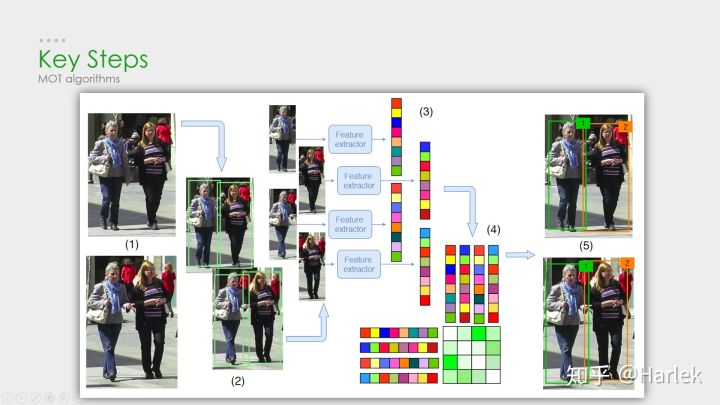
- 给定视频的原始帧
- 运行对象检测器以获得对象的边界框
- 对于每个检测到的物体,计算出不同的特征,一般为视觉特征和动作特征
- 之后,相似度计算步骤计算两个对象属于同一目标的概率
- 最后,关联步骤为每个对象分配数字ID
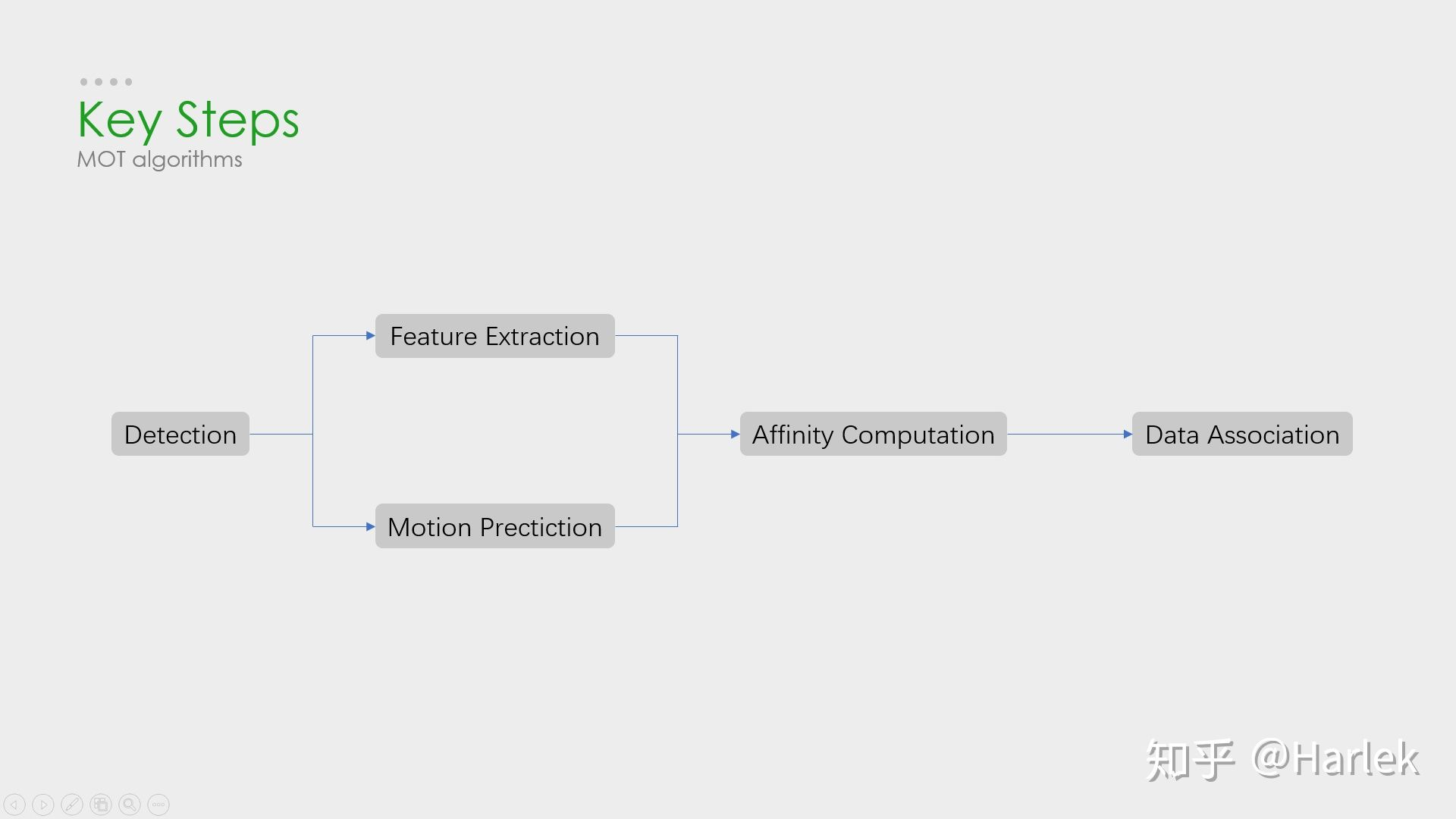
核心步骤:检测——特征提取、运动预测——相似度计算——数据关联
检测所最为重要的部分,对最后指标影响最大。
但是,多目标追踪的研究重点又在相似度计算和数据关联这一块。所以就有一个很大的问题:你设计出更好的关联算法可能就提升了0.1个点,但别人用一些针对数据集的trick消除了一些漏检可能就能涨好几个点。所以研究更好的数据关联的回报收益很低。因此多目标追踪这一领域虽然工业界很有用,但学术界里因为指标数据集的一些原因,入坑前一定要三思。
评价指标
作者首先说明了一个好的tracker应当有两个性质:
- 准确性:能够准确确定目标位置。
- 稳定性:能够持续追踪目标,并且每个目标有唯一轨迹。
因此,评价指标在设计时也要能够反映这两点,另外还应满足:
- 要调的参数少,自适应强。
- 清晰,易懂,直观。
- 普适性强,适用于2D,3D,不同追踪器等。
- 指标数量少,但评价能力强。
-
记录
-
Clear MOT metrics
MOTA用的最多,但是FN、FP的权重很大,更多检测的是检测的质量,而不是跟踪的效果
- IDscores
因为是基于匹配的指标,能够更好的衡量数据的好坏
数据集 Benchmark
- MOTChallenge
- 包含
MOT15(22videos,ACF)
MOT16(14videos,DPM),
MOT17(DPM,SDP,Faster R-CNN),
MOT19(8videos,CVPR19比赛,特别拥挤的场景) - 使用最多,专注于行人追踪
- KITTI
- 针对自动驾驶的数据集,MOT中使用较少
- Other datasets
SORT和DeepSORT

SORT
论文,代码
SORT算法是在卡尔曼滤波的基础上,用匈牙利算法将卡尔曼滤波预测的BBOX与物体检测的BBOX进行了匹配(关联两个BBox的核心算法是:用IOU(交集/并集)计算Bbox之间的距离),选择最优关联结果作为下一时刻的物体跟踪BBOX。
| 优点 | 缺点 |
|---|---|
| 速度快 | 对物体遮挡几乎没有处理,导致ID switch很频繁 |
| 没有遮挡的情况下准确度很高 | 有遮挡的情况下准确度很低 |
DeepSORT
优化了匈牙利算法中的代价矩阵,在IOU Match之前做了一次额外的级联匹配,利用了外观特征和马氏距离
# tracker.py
def _match(self, detections):
def gated_metric(racks, dets, track_indices, detection_indices):
"""
基于外观信息和马氏距离,计算卡尔曼滤波预测的tracks和当前时刻检测到的detections的代价矩阵
"""
features = np.array([dets[i].feature for i in detection_indices])
targets = np.array([tracks[i].track_id for i in track_indices]
# 基于外观信息,计算tracks和detections的余弦距离代价矩阵
cost_matrix = self.metric.distance(features, targets)
# 基于马氏距离,过滤掉代价矩阵中一些不合适的项 (将其设置为一个较大的值)
cost_matrix = linear_assignment.gate_cost_matrix(self.kf, cost_matrix, tracks,
dets, track_indices, detection_indices)
return cost_matrix
# 区分开confirmed tracks和unconfirmed tracks
confirmed_tracks = [i for i, t in enumerate(self.tracks) if t.is_confirmed()]
unconfirmed_tracks = [i for i, t in enumerate(self.tracks) if not t.is_confirmed()]
# 对confirmd tracks进行级联匹配
matches_a, unmatched_tracks_a, unmatched_detections = \
linear_assignment.matching_cascade(
gated_metric, self.metric.matching_threshold, self.max_age,
self.tracks, detections, confirmed_tracks)
# 对级联匹配中未匹配的tracks和unconfirmed tracks中time_since_update为1的tracks进行IOU匹配
iou_track_candidates = unconfirmed_tracks + [k for k in unmatched_tracks_a if
self.tracks[k].time_since_update == 1]
unmatched_tracks_a = [k for k in unmatched_tracks_a if
self.tracks[k].time_since_update != 1]
matches_b, unmatched_tracks_b, unmatched_detections = \
linear_assignment.min_cost_matching(
iou_matching.iou_cost, self.max_iou_distance, self.tracks,
detections, iou_track_candidates, unmatched_detections)
# 整合所有的匹配对和未匹配的tracks
matches = matches_a + matches_b
unmatched_tracks = list(set(unmatched_tracks_a + unmatched_tracks_b))
return matches, unmatched_tracks, unmatched_detections
# 级联匹配源码 linear_assignment.py
def matching_cascade(distance_metric, max_distance, cascade_depth, tracks, detections,
track_indices=None, detection_indices=None):
...
unmatched_detections = detection_indice
matches = []
# 由小到大依次对每个level的tracks做匹配
for level in range(cascade_depth):
# 如果没有detections,退出循环
if len(unmatched_detections) == 0:
break
# 当前level的所有tracks索引
track_indices_l = [k for k in track_indices if
tracks[k].time_since_update == 1 + level]
# 如果当前level没有track,继续
if len(track_indices_l) == 0:
continue
# 匈牙利匹配
matches_l, _, unmatched_detections = min_cost_matching(distance_metric, max_distance, tracks, detections,
track_indices_l, unmatched_detections)
matches += matches_l
unmatched_tracks = list(set(track_indices) - set(k for k, _ in matches))
return matches, unmatched_tracks, unmatched_detections
外观特征
外观特征就是通过一个Re-ID的网络提取的,而提取这个特征的过程和NLP里词向量的嵌入过程(embedding)很像,所以后面有的论文也把这个步骤叫做嵌入(起源应该不是NLP,但我第一次接触embedding是从NLP里)。
马氏距离
因为欧氏距离忽略空间域分布的计算结果,所以增加了马氏距离作为运动信息的约束。
\(dj\)和\(yi\)的空间与分布不同,马氏距离能够改善这一情况。设定一个固定阈值,在阈值之内的被认为是两者关联。但是马氏距离并没有改善长时间遮挡后关联不正确导致的ID switch。
什么是NLP的嵌入过程?
Related Work
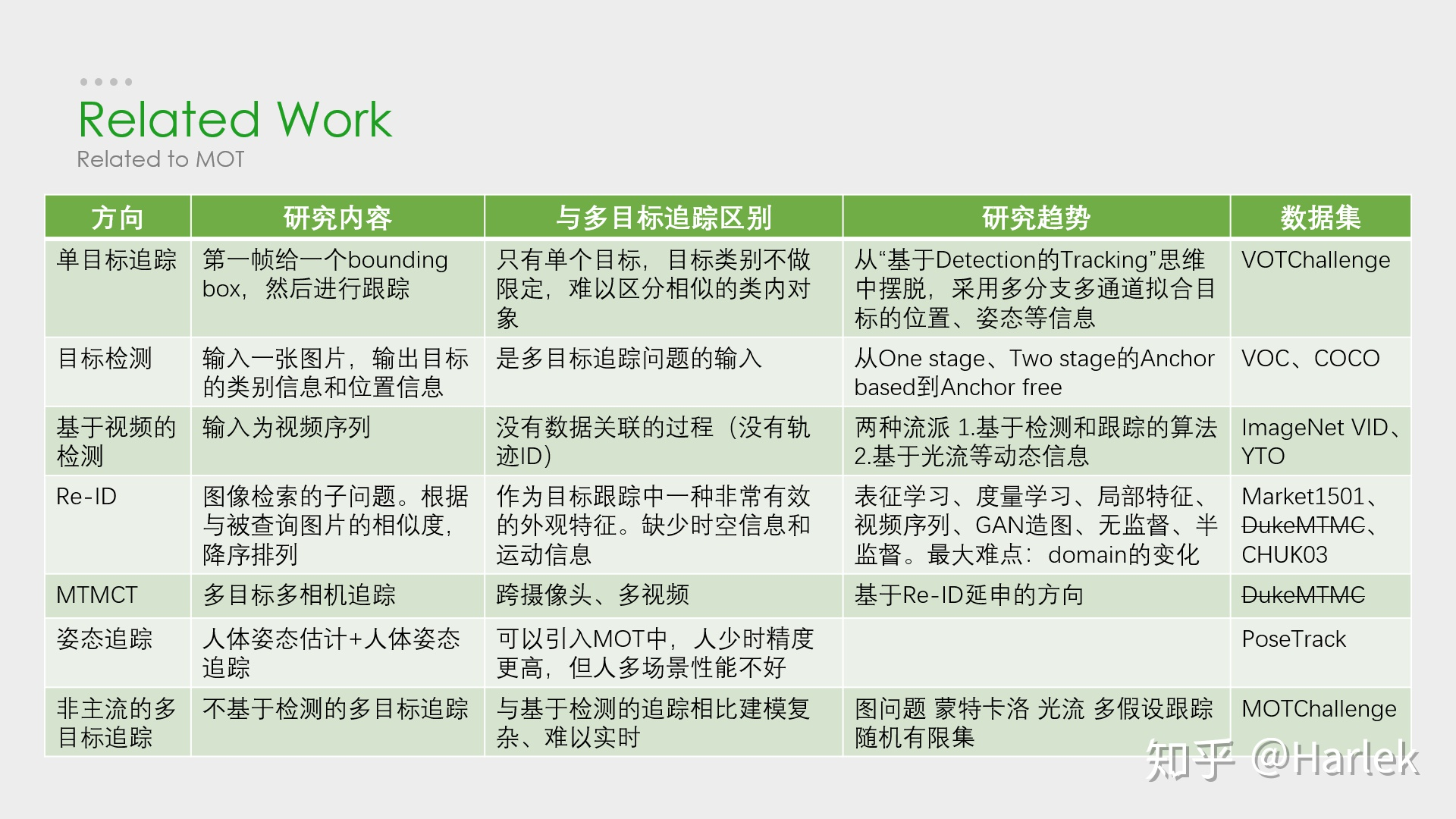
- 单目标追踪,VOT/SOT(hot)
- 目标检测,detection(hot)
- 基于视频的检测
较为冷门 - 行人重识别,Re-ID(hot)
- 多目标多相机追踪,MTMCT
因为隐私问题不再提供数据 - 姿态追踪
- 非主流的多目标追踪(不基于检测)

